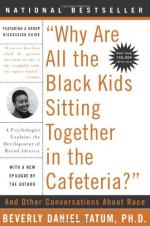
|
| Name: _________________________ | Period: ___________________ |
This quiz consists of 5 multiple choice and 5 short answer questions through Part IV, Beyond Black and White, Chapter 8, Critical Issues in Latino, American Indian, and Asian Pacific American Identity Development.
Multiple Choice Questions
1. According to the author, attempts to relate one's subculture to a broader culture can produce four reactions: assimilation, withdrawal, biculturalism and what?
(a) Reality.
(b) Diffusion.
(c) Marginalization.
(d) Foreclosure.
2. One advantage of affirmative action in helping blacks avoid racism is that they do not need to do what, according to the author?
(a) Petition for better treatment.
(b) Agree to make changes.
(c) See their mistreatment.
(d) Agree with the system.
3. When did Erik Erikson die?
(a) 1960.
(b) 1994.
(c) 1975.
(d) 1980.
4. What concept defined by the author holds the extended family as a reference group for social support?
(a) Miscegenation.
(b) Familism.
(c) Matrilineality.
(d) Marginalization.
5. In Part III, Understanding Whiteness in a White Context, Chapter 6, The Development of White Identity, Tatum recommends that whites find most positive redefinition by what means?
(a) Allying with other white resistors of racism.
(b) Allying with black resistors of racism.
(c) Ignoring the values of race.
(d) Allying with Asian resistors of racism.
Short Answer Questions
1. What is the fourth stage of William E. Cross, Jr.'s theory of Nigrescence?
2. What word means understood without being openly expressed?
3. What word means to depart or swerve, as from a procedure, course of action, or acceptable norm?
4. Who signed Executive order 11246?
5. Erik Erikson is most famous for having coined what phrase?
|
This section contains 226 words (approx. 1 page at 300 words per page) |

|




